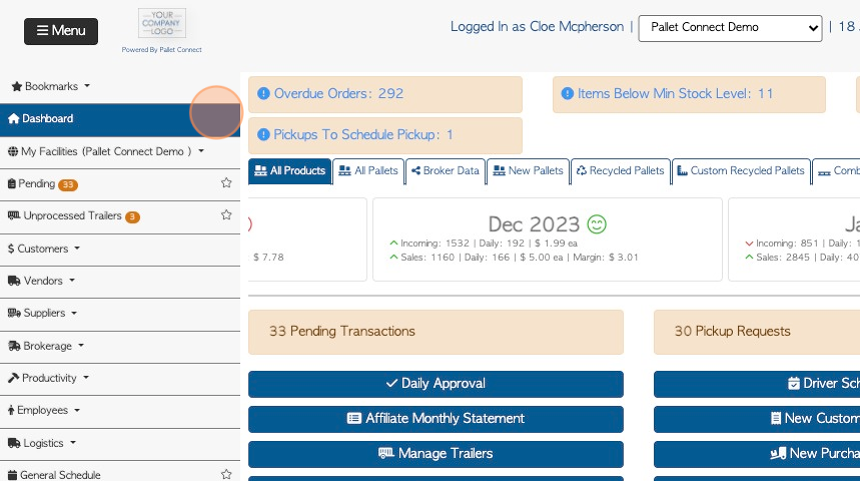Glossary
This glossary serves as a comprehensive reference guide, offering concise definitions and explanations for the key terms and acronyms associated with Pallet Connect. These definitions will help enhance understanding of the system and assist the user to navigate through Pallet Connect.

User:A person who has log-in credentials to utilize Pallet Connect. There are various user types, dependant on the role within the company. Each user type has a different screen view and has varying levels of functions and access to the system.
Employee:A person who is employed by the company. An employee may or may NOT be a Pallet Connect User. An employee who is not a user could have access to Pallet Connect through the kiosk, using a four digit PIN, for example warehouse workers or fork lift operators.
Driver:This user category is an internal driver, who is employed by the company. Drivers can be set up as "general drivers" or "restricted drivers".
Customer: A person or company that buys products from your organization.
Supplier: A person or company that your organization uses to buy NEW products, not recycled items. This is usually directly related to pallets e.g lumber, hardware. This category usually excludes expenses.
Vendor: A person or company that your organization uses to receive and buy USED pallets. For example, pallets to recycle.
Broker:Your organization completes work for this person or company, on their behalf.
Affiliate:A person or company that completes work on behalf of your organization.
External driver:A logistics company or non-employee driver that your organization utilizes to carry out transport services.
Brokerage module: This is used if your organization acts as a broker and outsources orders to a third party pallet company.
Workstation: This can be a machine or shared production area that is named and added into Pallet Connect. It is used in the production schedule. It can consist of single or multiple seats and employees can be assigned to these seats.
Kiosk:A feature that allows employees to capture production and stock management. It is accessed by a four digit PIN, allocated to the employee.
Head Office: This can be the headquarters of a company and locations of the same company can be linked. It can also be set up in the brokerage section. The head office represents the broker and their customers can be linked to this location.
Unprocessed trailer:This is a trailer load of recycled, unsorted pallets that has arrived on site at your organization but has NOT been offloaded or counted into stock.
BOM:The Bill of Materials (BOM) shows the components and materials needed to fulfill the order. Normally used for new, custom or combo pallets.
Production pack: The Production Pack consists of 6 documents to assist with production of an order: MATERIAL SUMMARY, DATA SHEET, COPY OF ORDER, LOAD SHEET, DELIVERY SLIP and ATTACHMENTS. These can be printed to use as paper copies
Load sheet:This document confirms the items and quantity that have been loaded into the truck.
Delivery slip/Pick up slip:It is used to confirm the items and quantities that were actually delivered. Companies also refer to this documents as a BOL (Bill of Lading) or POD (Proof of Delivery).
Proforma: An draft or preview invoice that estimates the cost of an order. This can be issued to the customer prior to the product delivery. The customer is not required to pay until a finalized invoice is sent.
Rebate: This is produced when your organization owes money to another company. It informs the other company the amount that is owed. For example, it can be sent to a Vendor once recycled pallets are picked up and sorted.
Recurring orders:These are orders that can be set up once but will repeat, dependent on the specifications of the customer. For example, an order can be set up to recur every week on the same day, for three months.
Bulk orders:This occurs when the total amount of product is captured on one order but it is separated into different deliveries, dependent on the specifications of the customer. For example, an order of 10'000 pallets can be divided into deliveries of 1000 pallets weekly, over 10 weeks.